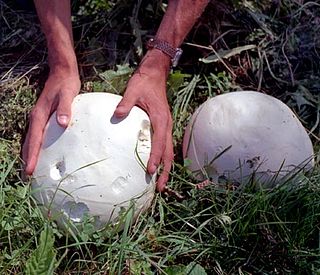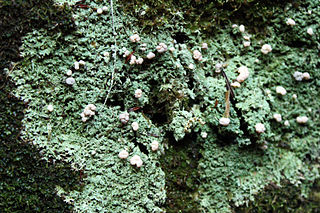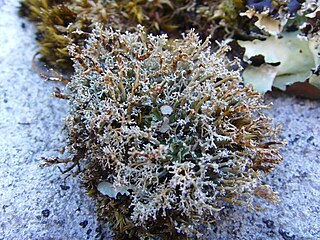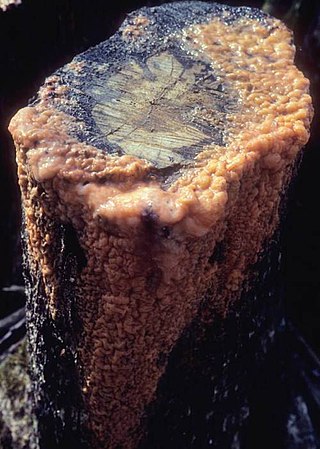
The Russulales are an order of the Agaricomycetes,. According to the Dictionary of the Fungi, the order consists of 12 families, 80 genera, and 1767 species. According to Species Fungorum, the order contains 13 families, 117 genera, and 3,060 species.

The Boletales are an order of Agaricomycetes containing over 1300 species with a diverse array of fruiting body types. The boletes are the best known members of this group, and until recently, the Boletales were thought to only contain boletes. The Boletales are now known to contain distinct groups of agarics, puffballs, and other fruiting-body types.

The Hymenochaetales are an order of fungi in the class Agaricomycetes. The order in its current sense is based on molecular research and not on any unifying morphological characteristics. According to one 2008 estimate, the Hymenochaetales contain around 600 species worldwide, mostly corticioid fungi and poroid fungi, but also including several clavarioid fungi and agarics. Species of economic importance include wood decay fungi in the genera Phellinus and Inonotus sensu lato, some of which may cause losses in forestry. Therapeutic properties are claimed for Inonotus obliquus ("chaga") and Phellinus linteus, both of which are now commercially marketed.

The Lycoperdales are a now outdated order of fungi. The order included some well-known types such as the giant puffball, the earthstars, and other tuberous fungi. They were defined as having epigeous basidiomes, a hymenium present, one to three layers in the peridium, powdery gleba, and brown spores.

The Bondarzewiaceae are a family of fungi in the order Russulales. The type species for both its genus and the family as a whole, Bondarzewia montana, closely resembles members of Polyporales, but has ornamented spores like those of Lactarius or Russula. This characteristic suggested the relationship between physically dissimilar species that eventually led to the restructuring of Russulales using molecular phylogeny. According to the Dictionary of the Fungi, the family contains 8 genera and 48 species.

The Suillaceae are a family of fungi in the order Boletales, containing the boletus-like Suillus, the small truffle-like Truncocolumella, as well as the monotypic genus Psiloboletinus. As of 2008, there are 54 species in the family. Gastrosuillus, once considered a distinct genus, has been shown with molecular analysis to be a recent evolutionary derivative of Suillus. Fuscoboletinus, described by Pomerleau and Smith in 1962, has also been subsumed into Suillus.

The Botryosphaeriaceae are a family of sac fungi (Ascomycetes), which is the type representative of the order Botryosphaeriales. According to a 2008 estimate, the family contains 26 genera and over 1500 species. Members of this order include notable plant pathogens.

The Helotiaceae are a family of fungi in the order Helotiales. The distribution of species in the family are widespread, and typically found in tropical areas. There are 117 genera and 826 species in the family.

The Mycenaceae are a family of fungi in the order Agaricales. According to the Dictionary of the Fungi, the family contains 10 genera and 705 species. This is one of several families that were separated from the Tricholomataceae as a result of phylogenetic analyses. Taxa in the Mycenaceae are saprobic, have a cosmopolitan distribution, and are found in almost all ecological zones. The family was circumscribed by Caspar van Overeem in 1926.

Bovista aestivalis is a small puffball in the family Agaricaceae. It is generally found in the coastal regions of California, but was reported from Korea in 2015. This fungus is often confused with Bovista dermoxantha, because of its similar peridium, and Bovista plumbea. The surest way to tell the species apart is to examine the spores and exoperidium, respectively, with a microscope.

The Serpulaceae are a family of fungi in the Boletales order. According to the Dictionary of the Fungi, the family contains 4 genera and 20 species. However, a molecular phylogenetics study showed that the genus Neopaxillus, which was formerly placed in this family, belongs in the family Crepidotaceae in the order Agaricales.

Icmadophila is a genus of crustose lichen. The genus has a widespread distribution in the Northern Hemisphere and contains six species. The only species found in North America, Icmadophila ericetorum, has a mint green crustose thallus that is dotted with bright pink apothecial disks, and is sometimes colloquially referred to as "fairy puke". It aggressively grows over mosses on well-rotted wood and peat. It looks very distinctive, but may be confused with species of Dibaeis.

Otidea is a genus of fungi in the family Pyronemataceae. The genus is widely distributed in northern temperate regions.
Campanophyllum is a fungal genus in the family Cyphellaceae. The genus is monotypic, containing the single species Campanophyllum proboscideum, found in Costa Rica. The genus was circumscribed in 2003 to accommodate the species formerly known as Lentinus proboscoides.

Sphaerophorus a genus of lichenized fungi in the order Lecanorales.
Cheilophlebium is a fungal genus in the order Agaricales. It is incertae sedis with respect to familial placement within the order. The genus is monotypic, containing the single species Cheilophlebium villosum, described by Philipp Maximilian Opiz in 1856. According to the Dictionary of the Fungi, the genus name is a nomen dubium.

Jean Baptiste Henri Joseph Desmazières was a merchant of Lille and an amateur mycologist. He was the editor of the scientific journals "Annales des sciences naturelles" and the "Bulletin de la société des sciences de Lille".

Fusicolla is a genus of seven species of ascomycete fungi in the family Nectriaceae. The genus was circumscribed by German mycologist Hermann Friedrich Bonorden in 1851. Fungi in the genus produce slimy orange sheets over the substrate, within which the perithecia can be either fully or partially immersed. Asexual spores are similar to those of Fusarium.
Hermann Friedrich Bonorden was a German physician and mycologist. During his career he served as a Regimentarzt in Köln.

Tulasnella aurantiaca is a species of fungus in the order Cantharellales. It produces orange-red, pustular, gelatinous anamorphic states on dead, deciduous wood. Originally described from Europe, it also occurs in North America where the species appears to be more common.
















